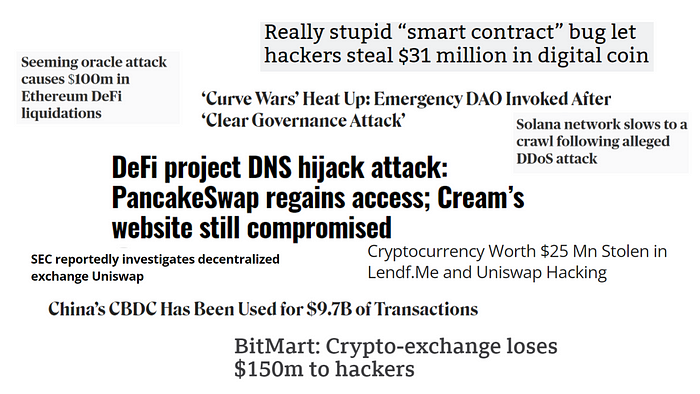Essential Elements of Fundamental Analysis in Blockchain
Written on
Chapter 1: Introduction to Fundamental Analysis
This guide will highlight critical aspects to examine during the fundamental analysis of blockchain and cryptocurrency projects.
Fundamental analysis serves as a cornerstone strategy for investing and trading within the blockchain and cryptocurrency domains. In this discussion, I will outline 17 core components of fundamental analysis, including:
- Whitepaper
- Source Code
- Use Cases
- Adoption
- Competitors
- Product Roadmap
- Technology Behind
- Team Behind
- Tokenomics
- Decentralization
- Scalability
- Security
- Real-Time Metrics
- On-Chain Metrics
- Listing Exchanges
- Governance
- Social Media Presence
Additionally, I will provide real-world project examples and useful resources for further exploration. Let’s get started!
Section 1.1: Whitepaper
The whitepaper acts as the official documentation for a blockchain project, offering users crucial insights. Commonly included information encompasses:
- Development Team
- Tools and Technologies Used
- Tokenomics
- Consensus Mechanisms
- Future Milestones
- Partnerships
- Real-World Applications
Section 1.2: Source Code
Legitimate blockchain initiatives typically adopt an open-source model, enabling public scrutiny. This allows users to delve into the code and assess both quality and security. Key information to extract includes:
- Developer Activity (features, commits, etc.)
- Audit Reports
- Smart Contracts
- Documentation and Transparency
Subsection 1.2.1: Example of Source Code Repository

Section 1.3: Use Cases
In an ideal world, every blockchain token aims to address a real-world problem. For instance:
- DeFi tokens propose decentralized financial solutions.
- Governance tokens facilitate user participation in governance.
- Gaming/Metaverse tokens enable in-game transactions.
- Payment tokens serve as cryptocurrencies.
Understanding the practical applications of coins/tokens is critical; hence, reviewing the official documentation is vital.
Section 1.4: Adoption
Adoption is a key metric in the blockchain/cryptocurrency landscape. Projects that lack recognition from retail investors or institutions risk fading away. Conversely, lesser-quality projects with effective marketing and broad adoption can experience significant growth.
Considering the "network effect" and potential growth levels of coins/tokens is essential during evaluations.
Section 1.5: Competitors
Blockchain encompasses a variety of solutions aimed at providing decentralized, scalable, and secure options. Within this space, numerous subcategories exist, such as:
- Payments
- NFTs
- Oracles
- Metaverse/Gaming
- Smart Contract Platforms
- Layer 2 Solutions
- Web 3
- File Storage
When investing, it's crucial to understand a project's position relative to its competitors.
Chapter 2: Key Metrics for Evaluating Projects
In this video, "How I Research Stocks - Step-by-Step Fundamental Analysis," the presenter outlines a systematic approach to analyzing stocks, which can also be applied to cryptocurrency projects.
Section 2.1: Product Roadmap
Successful projects maintain a clear mission and roadmap, often found in whitepapers or on social media. Expect to see announcements regarding:
- Upcoming features (e.g., staking, smart contracts)
- New projects
- Partnerships
- Events
- Updates to applications or platforms
- Network improvements (decentralization, scalability, security)
Section 2.2: Technology Behind
Understanding the underlying technology is crucial. Blockchain infrastructure, smart contracts, and dApps are crafted using various programming languages and frameworks. Key aspects to investigate include:
- Programming Languages (e.g., Solidity, Rust)
- Blockchain Libraries/Frameworks (e.g., Truffle, Remix)
- Frontend Technologies (e.g., React, Angular)
- Testing/Monitoring Tools (e.g., Etherscan)
Assessing whether the technology stack aligns with the project's goals is vital.
The second video, "Fundamental Analysis: How to Analyze and Value Stocks," provides insights into the valuation process, relevant for assessing blockchain projects.
Section 2.3: Team Behind
The caliber of the founding team significantly influences a project's success. Notable examples include:
- Cardano (ADA), founded by former Ethereum co-founder Charles Hoskinson.
- Polkadot (DOT), led by Ethereum co-founder Gavin Wood.
- Algorand (ALGO), created by renowned MIT professor Silvio Micali.
- Avalanche (AVAX), developed at Cornell University.
While not all successful projects share this narrative, a strong team often correlates with growth potential.
Takeaways
In summary, we have explored 17 foundational elements of fundamental analysis. Key insights include:
- Detailed whitepapers are indicative of quality projects.
- Publicly available source code is a positive sign.
- Legitimate use cases for tokens are essential.
- Broad adoption among users is crucial.
- Competitor analysis is necessary for informed decisions.
- Clear product roadmaps demonstrate vision.
- Advanced technology underpins successful projects.
- A strong team enhances a project's credibility.
- Fair and transparent tokenomics are essential.
- Decentralization and scalability are key features.
- Security remains a primary concern.
- Favor projects with stable real-time and on-chain metrics.
- Listings on reputable exchanges build trust.
- Governance policies must be evaluated.
- A strong social media presence can indicate project viability.
This content is intended for informational purposes only and should not be construed as financial or legal advice. Always consult a financial expert before making significant investment decisions.
If you found this information useful and would like to support my work, consider donating to my ETH wallet: 0x1779c21F79D3F1e63960990818B5bF03e89CbfFE.
For more insights, consider joining Medium using my referral link. Signing up through this link not only provides you access to unlimited content but also supports me and other writers you enjoy.